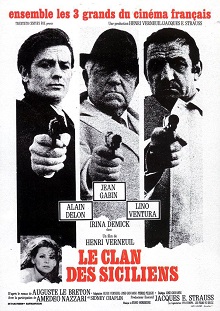Plot
In Paris, robber and murderer Roger Sartet escapes from custody with the help of the Manalese, a small, well-organized Sicilian Mafia clan consisting of patriarch Vittorio, his two sons, and his son-in-law. Sartet pays them with some valuable stamps he had stowed away, and the Manalese hide him in an apartment above the arcade game manufacturing company they own as a front. Jeanne, the French wife of Vittorio's elder son, looks after Sartet, but he sneaks out to see a prostitute at a hotel and narrowly avoids getting captured by Commissaire Le Goff.
While in prison, Sartet got to know an engineer who worked on the security for a jewelry exhibition in Rome before becoming incarcerated, and he learns the details of the system. He proposes that the Manalese help him rob the show, but they are dubious of the hot-headed outsider, so Vittorio and his old friend Tony Nicosia, who has lived in New York City for decades, go to the exhibition to check it out. They notice additional security measures negate Sartet's plan, but, after learning the show will soon be moved to New York, Nicosia comes up with a plan to steal the jewels in transit. He sends Jack, an alcoholic ex-pilot, to Paris to help the Manalese with the heist.
Figuring Sartet will need fake papers to leave the country, Le Goff tracks down the forger who made his previous fake passport. By coincidence, Vittorio was having the same man make several fake passports as part of the heist, and Le Goff finds the phone number of one of Vittorio's employees at the forger's studio. Le Goff questions Vittorio, but he says the employee no longer works for him.
The Manalese clan retreat to a hideout near the Italian border. Jeanne sunbathes nude in front of Sartet and they start to make love, but are interrupted by Roberto, her six-year-old nephew. She entreats him not to tell anyone.
Sartet goes to Rome, where he discreetly kidnaps Edward Evans, an English insurance man, and takes Evans' place among the small group of officials sent to guard the jewels during their trip on a passenger flight. As Jack, Jeanne, Vittorio, and his sons wait to catch the plane when it stops in Paris, they are surprised to see Evans' wife arrive and, intending to accompany her husband to New York, board the plane early. Thinking fast when Mrs. Evans returns from the plane, Vittorio leads her to believe that Evans will be on the same flight the next day, as that is when the jewels are really being transported. While the plane loads and takes off, Mrs. Evans puts through a call to her husband's hotel in Rome. When she learns he never arrived there, she contacts the police and identifies Sartet as one of the men she saw on the plane.
During the plane's descent towards New York, the Manalese clan hijack the aircraft. Warned of Sartet's imminent arrival in the United States, the local police race to the airport, but Jack lands the plane on a new stretch of highway that is not yet open. Nicosia's men are waiting to unload the jewels, and the gangsters split up. Sartet hides out in New York while he waits for his share of the proceeds and a ticket to Veracruz.
Back home in Paris, the Manalese family watch a film in which a couple start to make love, and Roberto exclaims that it looks just like what Sartet was doing with Jeanne. Though Jeanne denies everything, Vittorio lures Sartet back to Paris by withholding his share of the loot. Jeanne calls Sartet's sister, Monique, and asks her to warn him of the trap. Monique goes to the airport, where she finds Vittorio's sons and son-in-law waiting for Sartet, and they are all arrested by Le Goff, who was monitoring Monique's telephone.
Sartet, who had arrived in Paris by an earlier flight than expected, calls Vittorio to arrange a meeting at an isolated spot. Vittorio brings Jeanne with him, and, while Sartet examines the money, Vittorio shoots Sartet and Jeanne dead, leaving the cash by the corpses. When Vittorio returns home, Le Goff is waiting to arrest him.
